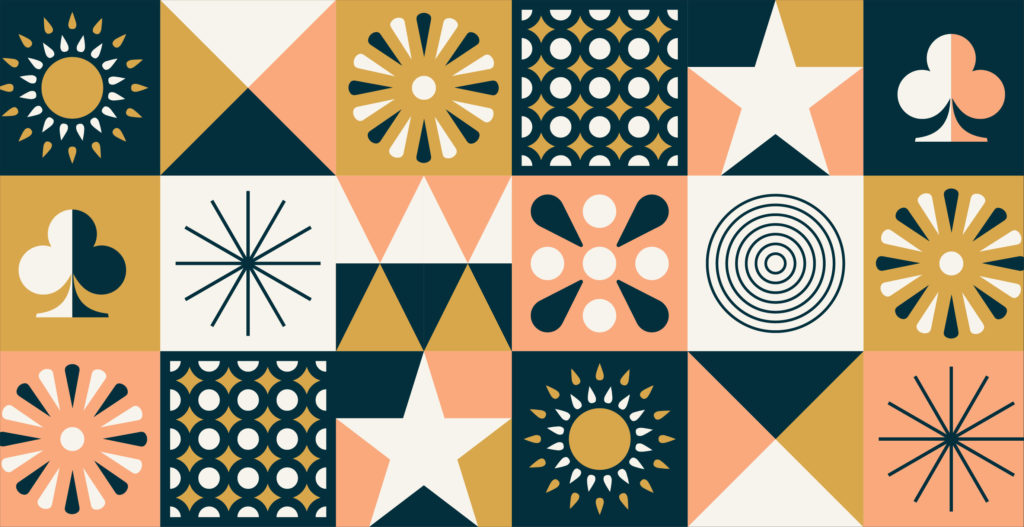The Power of Symbols in Graphic Design

From cuneiform tablets to pictograms to hieroglyphs, signs and symbols have always evoked a certain meaning and a message. I’ve been tearing through Miranda Bruce-Mitford’s book The Illustrated Book of Signs & Symbols, and it’s been fascinating to learn how these signs and symbols have been used throughout time and how many still retain their original meaning. It’s incredibly applicable to many of the projects I work on as a graphic designer, and in fact, I’ve already applied what I’ve learned to several recent branding projects.
To demonstrate the effectiveness of signs and symbols in branding, we first need to differentiate between the two. According to Bruce-Mitford, a sign “is an object or idea that represents or points to something else in a fairly straightforward way.” Think of advertising for example: an ad is a clear message pointing the viewer to a product. Another example is traffic signs: they clearly tell you the road rules that you are meant to follow.
Symbols, on the other hand, act to represent abstract concepts or ideas. For instance, a flame can represent light, brightness, warmth and creativity. I’m specifically intrigued by symbolism and how it can be used in logo design.
In a logo, we often refer to something like Apple’s apple as a mark. Because we’re talking symbols, I’m going to focus on the mark alone, rather than the typography.
A mark could be….
- An abstracted letter, like the golden arches of McDonald’s.
- A monogram, like Volkswagen.
- An object, like the Twitter bird.
- Multiple objects combined, like the Airbnb logo (combines heart shape and location pin).
- Completely abstract and shape-driven, like the red, white and blue globe from Pepsi.
- Completely abstract and line-driven, like the bars in Cisco.
The tell-tale sign of a really strong mark is when it can be used without the text and still be recognizable. Beyond having a strong visual presence, it needs to have a deeper meaning that can tell a story.
I’m going to share some excerpts from Bruce-Mitford’s book. You’ll recognize these symbols and likely have your own connotations, but there are some details and history you may not have been aware of (or at least, I wasn’t!).
Dog
In Greek mythology, Cerberus was the three-headed dog that guarded the gates of the realm of the dead and acted as a spirit guide. In Judaic and Islamic traditions, the dog is considered unclean, while in Zoroastrianism it is regarded highly. Everywhere, however, the dog is a symbol of faithfulness and protectiveness, of blind love and obedience. The dog is the eleventh sign of the Chinese zodiac.
Shamrock
Once an Arabian symbol, the shamrock, or clover, was also adopted by Christians. Its three leaves signify the Holy Trinity: Father, Son and Holy Spirit. The plant is the emblem of Ireland and of its patron saint, St. Patrick. A four-leaf clover is thought to bring good luck.
Sun & Moon
The sun and moon have always played a powerful role in imagery. For many cultures all over the world the sun is the embodiment of male energy, light and warmth, and the moon of female mystery and creation. Both are symbolic of death and rebirth: the sun because of its daily rising and setting, the moon because of its monthly waxing and waning between new moon and full moon. The sun’s energy warms the land and ripens crops, while the moon’s gravity influences the waters, controlling the flow of tides.
Gloves
Originally, gloves were a symbol of power and were presented at investiture ceremonies. Until recently, a lady or a gentleman was always expected to wear gloves in public. To handle something with kids’ gloves is to treat someone or something with the utmost care.
To think these are just four examples among thousands! The symbols you can pull inspiration from when designing your mark are endless, and the visual style and treatment you give your mark can also affect the emotive response a viewer will feel when looking at it.
Now, go forth and create!

